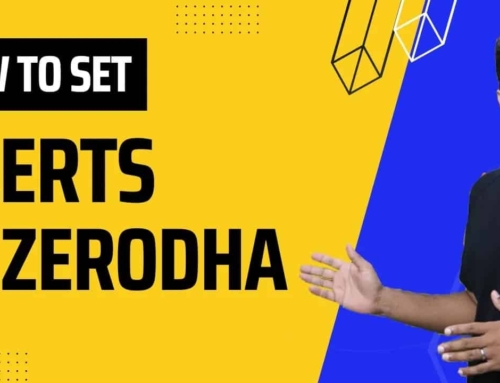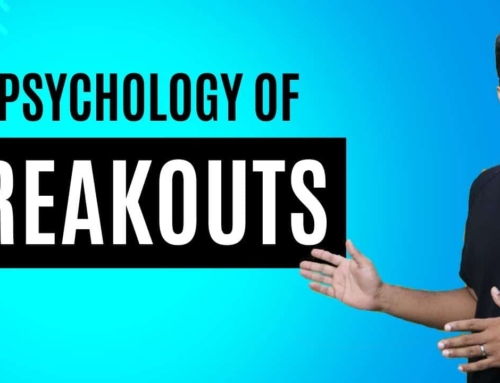Limit vs Market Orders | Must-Watch for Beginners
One of the first things that you ought to learn as a beginner in the stock market is to place buy or sell orders. When you get to the order entry screen, you see these 2 options, market and limit, and a lot of beginners then start wondering that what exactly is the difference between the two and which one to pick.
In this video, I will explain the difference between limit and market orders using a live example. But before we get going, if you’re new to this channel, do subscribe, because, through this channel, we explain complex stock market concepts simply and easily that even a beginner can easily understand.
Let’s get started with limit and market orders. To understand what these orders are, you first need to know the life cycle of an order and how an order gets executed. So when you’re placing an order, you’re using your brokers trading terminal. Now your broker can be Zerodha, Sharekhan or ICICI Direct and you might be using their mobile app or web browser and it doesn’t matter.
When you place an order, your broker sends that order to the stock exchange and the exchange can be either NSE or BSE. What the stock exchange does are match buyers and sellers. It acts as a broker and all it does is to match the buyers with the sellers.
When the stock exchange looks at your buy order, it asks who would be the best seller for this buy order? Who should I match it to? As soon as it finds one, your order gets executed. What executed means is that as a buyer, you get your shares and the seller gets paid for those shares.
So both are happy and life is good. Now with this understanding, let’s go back to the limit and market orders. Limit and market orders are two different kinds of instructions that you give to the stock exchange about the price at which you want to buy or sell your shares.
Let us start with the limit order. In the case of a limit order, you specify your price. For example, you can say that I want to buy 500 shares of a stock at a hundred rupees. When your order gets to the stock exchange, it will only match your order with the seller who is willing to sell at a hundred rupees or at a price that is lower than that.
All the other sellers that are asking for more than a hundred rupees will be ignored. When you place a limit order, the stock exchange makes sure that you never pay more than your specified price. In this case, you will never pay a single rupee more than your specified price of one hundred rupees.
Let’s take a live example to understand this. So here, in this case, we have ICICI bank and I want to buy one share of ICICI bank. When I get down to the screen right here, I can see there are different options. We have the market, limit, stop-loss and stop-loss market.
About stop-loss and stop-loss market orders, we have discussed that in a separate video and you might want to check that one out, but as of now, we are going to focus on market and limit orders. Let me just place this order. Since I want to do this for intraday purposes, I will select MIS and since we are trying to place a limit order, let me select limit and pick a price.
Let’s say 386 rupees, and now I can place my order, hit the button “Buy”. As you can see here, my order has been sent to the exchange, but it is still not executed and still in open status. Why is it open and not executed? Because I have told the stock exchange that I do not want to buy ICICI bank at 386 rupees.
Hence this order is going to sit here until the price of ICICI bank comes down to 386 rupees. As you can see here, the stock price of ICICI bank eventually came down and the order got executed. This is a typical example of limit order.
The one thing that we have to remember about limit orders is that they will only get executed if the exchange finds a price that you specified or something better than that. What happens is in cases like this is you can always go back and modify your order.
Let’s take one more example. So here we have Gail, and I want to buy one share of gain at 99 rupees. So I place this order and the order is currently waiting for execution.
After some time, when I realize that this order is not going to be executed at 99 rupees, I modify the price and make it to 99.95 rupees, which has a higher chance of execution. When I modified and placed that order again, it got finally executed.
The one thing that you have to remember with limit orders is that once you place the order, sometimes you have to go back and modify your orders. There is one more question that is typically asked about limit orders. What if I did a mistake and give a price that is much higher than the market price.
What will happen? Do we have to pay the price of that mistake? Actually, not as in these cases, stock exchanges are very smart. It realizes that you have made a mistake.
Let me explain this with an example. Assume that I want to buy one share of ICICI bank, but instead of giving a price of 387 rupees, I by mistake enter 400 rupees. I want to see if the stock exchange executes my order at 400 rupees, or I will be getting something reasonable. Let us try this thing out.
I’m going to place my order and now let’s go and check what the price eventually was. As you can see here that even though by mistake, I gave the price as 400 rupees, the stock exchange was smart and executed it at the market price. This is what typically happens. If you give a price higher than the last traded price or the current market price, the stock exchange executes it like a market order and that is the best price that you get. Hence you don’t have to pay a penalty for making that kind of a mistake.
There is however one more question that people ask about limit orders. Is it okay if I place an order and it doesn’t get executed, what happens to it? Does it stay there and then the next day it will keep trying or what exactly would happen? So the way things work is that if your order doesn’t get executed all day long, it will automatically get cancelled by the end of the day.The next day, if you still want to buy, you have to place an order again.
Let’s talk about the market order, which is much simpler. In the case of a market order, you do not specify the price. You want the stock exchange to get your order executed as soon as possible.
This makes the life of the stock exchange much easier. So the exchange will look for the best offer at the moment that you place your order and fulfil that.
Let’s take a live example. So we take the same case here and again, we will place a market order for ICICI Bank. So life is going to be very easy here.
All we have to do is select “Market” and hit the Buy button. As you can see, the order gets executed instantly and I get a price of 387.2. At the time of placing the order, I did not know exactly what the price is going to be, but the exchange found out a seller who was willing to sell me 1 share of ICICI bank at 387.3 rupees.
There is one last thing, which you should know is that all the examples that I have taken in this video are for Buy orders, but the logic of limit versus market orders works the same way for Sell orders as well.
So guys, in this video using live examples, I gave you an overview of how limit orders and market orders work. Which of these two orders should you then be using? That is something that we’ll be covering in part two of this video and make sure to check it out as well.
.
Limit vs Market Orders | Must-Watch for Beginners
One of the first things that you ought to learn as a beginner in the stock market is to place buy or sell orders. When you get to the order entry screen, you see these 2 options, market and limit, and a lot of beginners then start wondering that what exactly is the difference between the two and which one to pick.
In this video, I will explain the difference between limit and market orders using a live example. But before we get going, if you’re new to this channel, do subscribe, because, through this channel, we explain complex stock market concepts simply and easily that even a beginner can easily understand.
Let’s get started with limit and market orders. To understand what these orders are, you first need to know the life cycle of an order and how an order gets executed. So when you’re placing an order, you’re using your brokers trading terminal. Now your broker can be Zerodha, Sharekhan or ICICI Direct and you might be using their mobile app or web browser and it doesn’t matter.
When you place an order, your broker sends that order to the stock exchange and the exchange can be either NSE or BSE. What the stock exchange does are match buyers and sellers. It acts as a broker and all it does is to match the buyers with the sellers.
When the stock exchange looks at your buy order, it asks who would be the best seller for this buy order? Who should I match it to? As soon as it finds one, your order gets executed. What executed means is that as a buyer, you get your shares and the seller gets paid for those shares.
So both are happy and life is good. Now with this understanding, let’s go back to the limit and market orders. Limit and market orders are two different kinds of instructions that you give to the stock exchange about the price at which you want to buy or sell your shares.
Let us start with the limit order. In the case of a limit order, you specify your price. For example, you can say that I want to buy 500 shares of a stock at a hundred rupees. When your order gets to the stock exchange, it will only match your order with the seller who is willing to sell at a hundred rupees or at a price that is lower than that.
All the other sellers that are asking for more than a hundred rupees will be ignored. When you place a limit order, the stock exchange makes sure that you never pay more than your specified price. In this case, you will never pay a single rupee more than your specified price of one hundred rupees.
Let’s take a live example to understand this. So here, in this case, we have ICICI bank and I want to buy one share of ICICI bank. When I get down to the screen right here, I can see there are different options. We have the market, limit, stop-loss and stop-loss market.
About stop-loss and stop-loss market orders, we have discussed that in a separate video and you might want to check that one out, but as of now, we are going to focus on market and limit orders. Let me just place this order. Since I want to do this for intraday purposes, I will select MIS and since we are trying to place a limit order, let me select limit and pick a price.
Let’s say 386 rupees, and now I can place my order, hit the button “Buy”. As you can see here, my order has been sent to the exchange, but it is still not executed and still in open status. Why is it open and not executed? Because I have told the stock exchange that I do not want to buy ICICI bank at 386 rupees.
Hence this order is going to sit here until the price of ICICI bank comes down to 386 rupees. As you can see here, the stock price of ICICI bank eventually came down and the order got executed. This is a typical example of limit order.
The one thing that we have to remember about limit orders is that they will only get executed if the exchange finds a price that you specified or something better than that. What happens is in cases like this is you can always go back and modify your order.
Let’s take one more example. So here we have Gail, and I want to buy one share of gain at 99 rupees. So I place this order and the order is currently waiting for execution.
After some time, when I realize that this order is not going to be executed at 99 rupees, I modify the price and make it to 99.95 rupees, which has a higher chance of execution. When I modified and placed that order again, it got finally executed.
The one thing that you have to remember with limit orders is that once you place the order, sometimes you have to go back and modify your orders. There is one more question that is typically asked about limit orders. What if I did a mistake and give a price that is much higher than the market price.
What will happen? Do we have to pay the price of that mistake? Actually, not as in these cases, stock exchanges are very smart. It realizes that you have made a mistake.
Let me explain this with an example. Assume that I want to buy one share of ICICI bank, but instead of giving a price of 387 rupees, I by mistake enter 400 rupees. I want to see if the stock exchange executes my order at 400 rupees, or I will be getting something reasonable. Let us try this thing out.
I’m going to place my order and now let’s go and check what the price eventually was. As you can see here that even though by mistake, I gave the price as 400 rupees, the stock exchange was smart and executed it at the market price. This is what typically happens. If you give a price higher than the last traded price or the current market price, the stock exchange executes it like a market order and that is the best price that you get. Hence you don’t have to pay a penalty for making that kind of a mistake.
There is however one more question that people ask about limit orders. Is it okay if I place an order and it doesn’t get executed, what happens to it? Does it stay there and then the next day it will keep trying or what exactly would happen? So the way things work is that if your order doesn’t get executed all day long, it will automatically get cancelled by the end of the day.The next day, if you still want to buy, you have to place an order again.
Let’s talk about the market order, which is much simpler. In the case of a market order, you do not specify the price. You want the stock exchange to get your order executed as soon as possible.
This makes the life of the stock exchange much easier. So the exchange will look for the best offer at the moment that you place your order and fulfil that.
Let’s take a live example. So we take the same case here and again, we will place a market order for ICICI Bank. So life is going to be very easy here.
All we have to do is select “Market” and hit the Buy button. As you can see, the order gets executed instantly and I get a price of 387.2. At the time of placing the order, I did not know exactly what the price is going to be, but the exchange found out a seller who was willing to sell me 1 share of ICICI bank at 387.3 rupees.
There is one last thing, which you should know is that all the examples that I have taken in this video are for Buy orders, but the logic of limit versus market orders works the same way for Sell orders as well.
So guys, in this video using live examples, I gave you an overview of how limit orders and market orders work. Which of these two orders should you then be using? That is something that we’ll be covering in part two of this video and make sure to check it out as well.
.



![What is Virtual Contract Note [Zerodha]](https://www.vrdnation.com/wp-content/uploads/2023/10/maxresdefault-virtual-note-500x383.jpg)



Leave A Comment